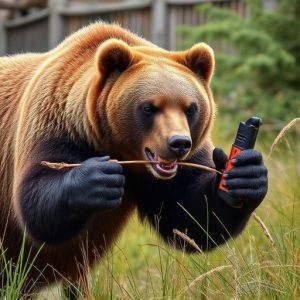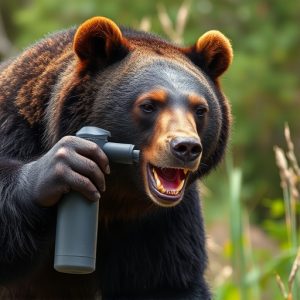Bear Spray Safety: Choosing, Storing, and Using Effectively
Bear spray storage at optimal temperatures (-20°F/-29°C to 120°F/49°C) ensures its e…….
Bear spray storage at optimal temperatures (-20°F/-29°C to 120°F/49°C) ensures its effectiveness. Choose brands designed for your region's climate and follow storage instructions. Maintain a range of -4°C to 21°C, avoiding extreme heat or cold. Know local laws regarding bear spray possession and usage for enhanced safety in bear country.
“Backpacking enthusiasts, especially those venturing into bear country, must-have a reliable safety gear—bear spray. This article guides you through essential aspects of backpacking bear spray, ensuring your peace of mind while exploring nature. From understanding the spray’s mechanics to selecting the right product and legal considerations, we cover it all. Learn about optimal storage at the proper temperature to maintain efficacy, and discover effective usage techniques during encounters with these majestic yet potentially dangerous animals.”
- Understanding Bear Spray: What It Is and How It Works
- Choosing the Right Bear Spray for Your Adventure
- Proper Storage: Ensuring Optimal Efficacy at the Right Temperature
- Safety Measures: How to Use Bear Spray Effectively in Encounters
- Legal Considerations and Regulations for Carrying Bear Spray
Understanding Bear Spray: What It Is and How It Works
Bear spray, also known as bear deterrent or bear repellent, is a crucial safety gear for anyone venturing into bear country. It’s a powerful tool designed to deter and scare bears when faced with an encounter. This pepper-based spray uses capsaicin, the same compound found in chili peppers, to cause irritation and temporary blindness in the animal’s eyes and nose, enabling the user to escape unharmed.
Proper storage of bear spray is essential for its effectiveness. The recommended temperature range for storing bear spray is typically between -20°F (-29°C) and 120°F (49°C). Extreme temperatures can affect the spray’s performance, making it less potent or even freezing if left at sub-zero levels, impacting its spraying capabilities. Ensuring your bear spray is stored within this range guarantees optimal functionality when you need it most during a bear encounter in the wild.
Choosing the Right Bear Spray for Your Adventure
When selecting bear spray, one of the most critical factors is choosing a product designed for your specific adventure’s conditions. Different environments have varying temperatures, which can significantly impact the spray’s performance and effectiveness. For instance, bear spray formulated for cold climates may solidify in warmer temperatures, losing its potency. Conversely, hot-weather formulas can become too thin and spread less precisely when it’s chilly.
Thus, it’s essential to select a brand that offers products suitable for your destination’s typical temperature range. Always check the storage instructions, which often include recommended minimum and maximum temperatures. Storing bear spray in conditions that exceed these guidelines could compromise its reliability when you need it most.
Proper Storage: Ensuring Optimal Efficacy at the Right Temperature
Proper storage of your bear spray is crucial for ensuring its optimal efficacy, especially in unpredictable wilderness conditions. Keep it in a cool, dry place, ideally stored at temperatures between -20°C to 40°F (-4°F to 4°C). Extreme heat or cold can compromise the spray’s performance and stability. Avoid leaving it in direct sunlight, as this can accelerate degradation of the active ingredients. In colder climates, consider using a bear spray storage container designed to maintain optimal temperatures, especially if you’ll be spending extended periods outdoors during winter months.
Remember that improper storage can reduce the spray’s effectiveness when you need it most. Always check the product instructions for specific storage guidelines and ensure your gear is ready when venturing into bear country.
Safety Measures: How to Use Bear Spray Effectively in Encounters
When faced with a bear encounter, proper usage of bear spray can be a lifesaver. It’s crucial to remember that bear spray is a tool for deterrence, not a guarantee of safety. Effective use requires understanding how and when to deploy it. Always keep your spray within easy reach, especially during hikes in known bear country. Before an encounter, ensure the can is oriented correctly with the nozzle facing forward; upon activation, aim low, towards the ground, and slightly sideward to maximize coverage.
The proper temperature range for storing bear spray is key to its effectiveness. Most brands recommend keeping it between 50°F (10°C) and 70°F (21°C). Extreme temperatures can cause the spray to freeze or become too viscous, impacting its performance. Regularly check the condition of your spray, especially during prolonged storage, to ensure it remains ready for use in case of an unexpected encounter.
Legal Considerations and Regulations for Carrying Bear Spray
When considering bear spray as part of your safety gear while backpacking, it’s crucial to understand the legal landscape surrounding its carriage. Regulations vary significantly across regions, with some areas permitting bear spray for recreational activities and others restricting its use to specific situations like hunting or wilderness protection. Before packing bear spray, check local, state, or provincial laws to ensure compliance. Additionally, familiarize yourself with guidelines on proper storage, including maintaining the recommended Proper Temperature for Bear Spray Storage to ensure its effectiveness.
Bear spray regulations often include restrictions on quantities allowed, types of containers permitted, and where it can be carried (e.g., in a backpack or stored in a vehicle). Some regions may also mandate training or certifications for responsible use. Staying informed about these legal considerations ensures not only compliance but also enhances your safety during outdoor adventures in bear country.
When embarking on outdoor adventures in bear country, incorporating bear spray into your safety kit is a wise decision. By understanding its functionality, selecting the appropriate product, and adhering to proper storage guidelines, including ideal proper temperature for bear spray storage, you can enhance your safety during encounters with these majestic yet potentially dangerous animals. Remember, knowledge and preparation are key to navigating these wild environments with confidence.


